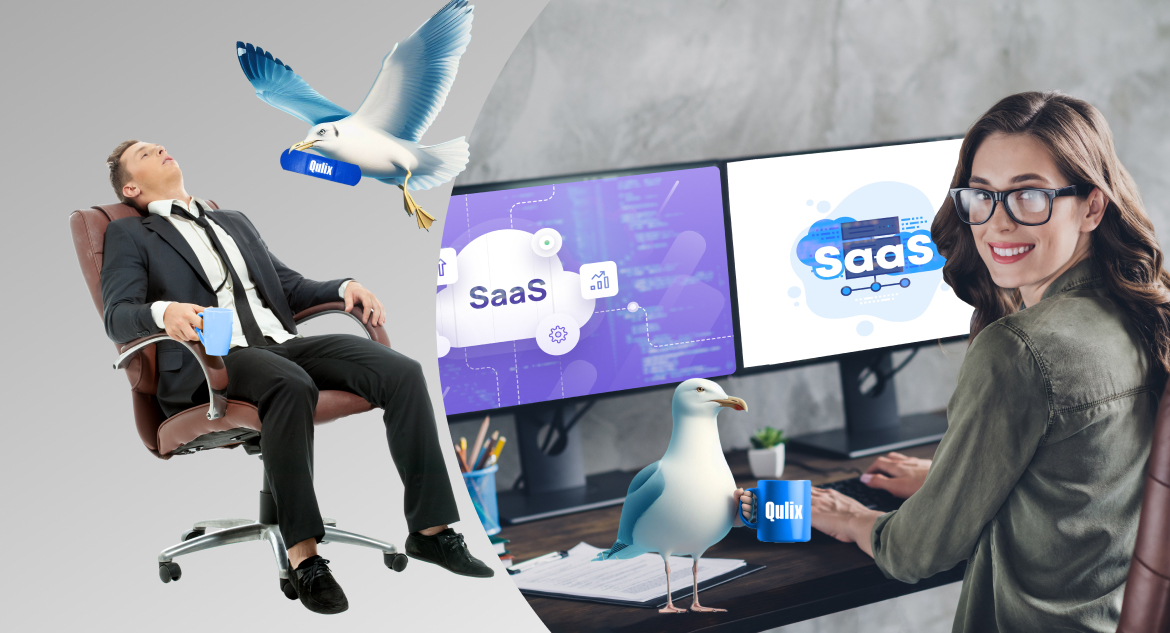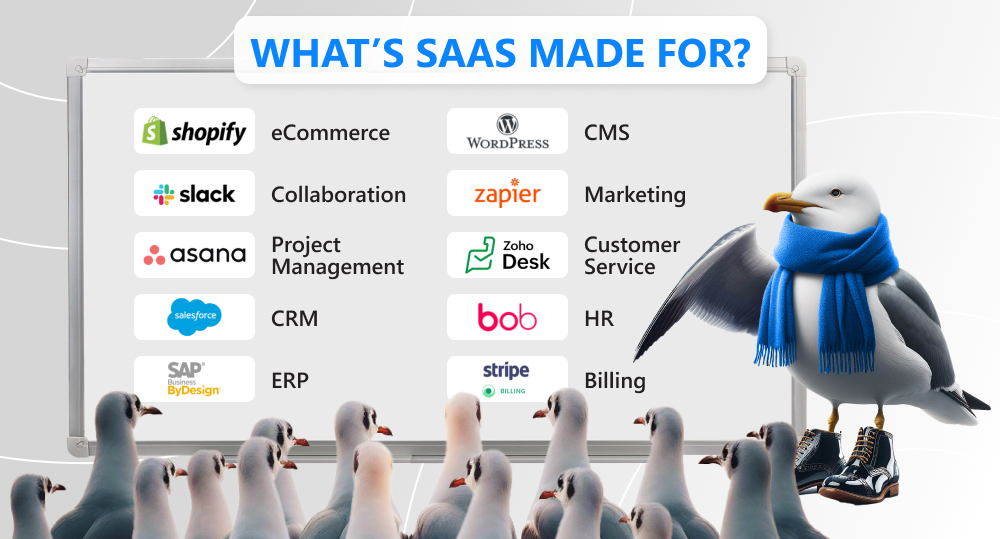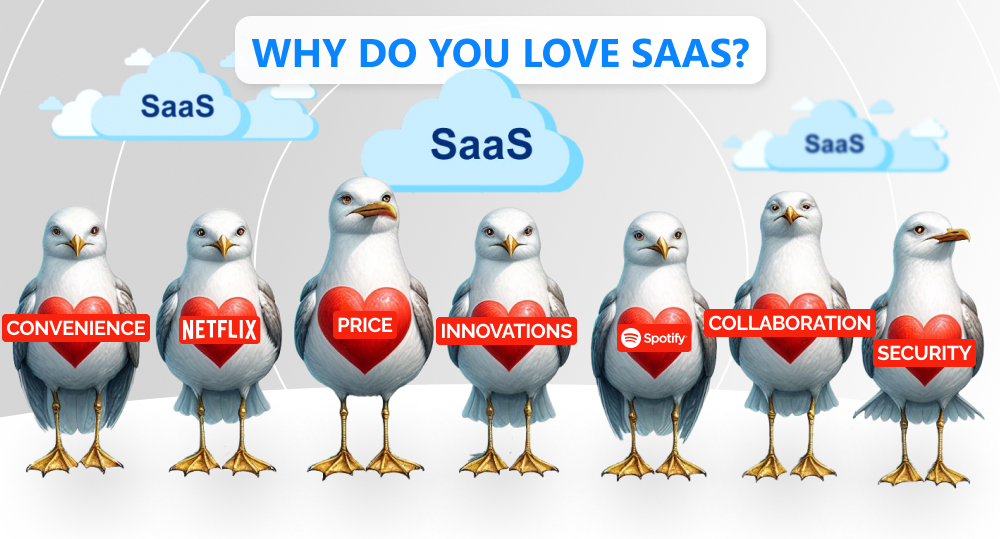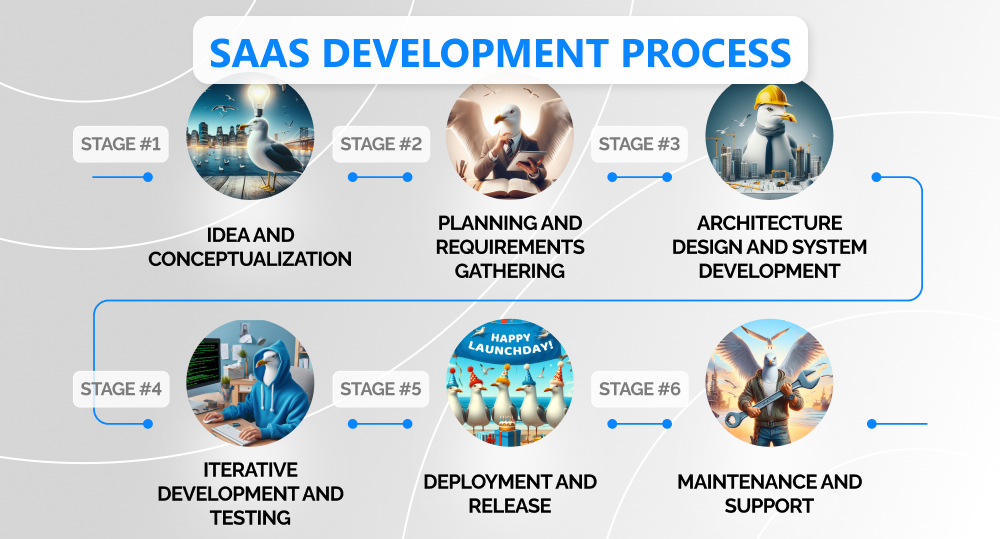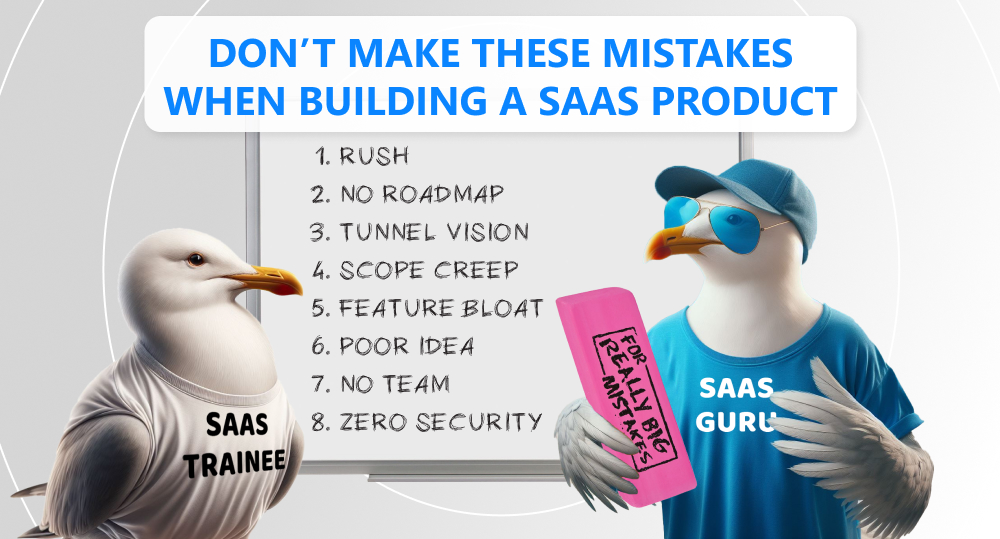The path of SaaS product development can be extremely rough. Even after launch. Even for the industry's torch-bearers. Guess which SaaS product had to ramp up its infrastructure to handle a huge spike in market demand due to the pandemic? Zoom. Which company had to revamp its software from top to toe when streaming technology emerged? Netflix. And who is constantly killing its SaaS solutions, leaving virtual graveyards in its wake? Google.
You got the picture, everyone in this field hits bumps along the way. But with sufficient preparation, you can steer clear of the errors made by big names in the past. That's exactly what our article is all about. Let's hit the road!

written by:
Vladislav Stanishevsky
Software Architect
Contents
Know Your Thing: What Is a SaaS Product?
Do you know how many SaaS apps a typical organization uses on average? A recent study by BetterCloud reveals that as of 2023, the number has reached 130!
If you're reading this blog post, you probably want to jump on board with these companies. Let's refresh your knowledge to ensure you're in the market for a SaaS product, not IaaS, DaaS, or anything else from the “X-as-a-service” list.
SaaS is an acronym for software as a service, a licensing and delivery model where software is centrally hosted and available from any location with an internet connection. In simpler terms, rather than purchasing and installing an application directly on your device, you can access it via the internet on a subscription basis.
The Diversity of SaaS Products
At the heart of SaaS tools lies their flexibility, apparent in the multitude of existing solutions. Regardless of a company's size or industry, there is bound to be an application that can optimize its various business processes and enhance output. Here are the options at your disposal:
- eCommerce solutions;
- Collaboration software;
- Project management tools;
- Vertically focused SaaS solutions;
- Data analytics services;
- Customer relationship management (CRM) software;
- Enterprise resource planning (ERP) solutions;
- Content management systems (CMS);
- Sales and marketing software;
- Customer service applications;
- Human resource management services;
- Billing software.
Why Does the World Love SaaS?
It appears everyone is writing off the days of desktop email clients, ages-to-load CRM systems, and Microsoft Word with Clippy, the world's most hated virtual assistant. Today, the SaaS industry is all the rage. What accounts for its widespread appeal?
Unparalleled Convenience and Accessibility
SaaS eliminates the barriers and limitations inherent in traditional work settings: time, location, and equipment. Through the SaaS model, you access powerful software and services directly over the internet, avoiding the burden of costly installation and constant hardware upgrades.
Accessibility is synonymous with the essence of SaaS. Whether you use a desktop, laptop, Android, or iOS device, you can access any SaaS application without compatibility issues. This flexibility empowers teams to work on the go, seamlessly switch between devices, and stay productive no matter where they are.
Flexible Pricing Model
Rather than investing in long-term commitments and expensive software licenses, SaaS gives companies the option to adopt a flexible pricing strategy. The two most popular payment models are subscription-based and pay-as-you-go.
When choosing a subscription-based plan, you will have to pay a recurring fee (monthly or annually) to access the software. That said, SaaS providers offer different subscription tiers, each with a distinct set of features. This grants freedom to pick a plan that fits your company's budget and requirements. You can start with the basic tier and upgrade to a higher one when certain events occur, such as staff expansion or the launch of a new project. Several examples of SaaS companies that follow this pricing model include:
- Netflix;
- Spotify;
- Salesforce.
The pay-as-you-go model is a pricing strategy that allows you to pay only for the resources or features used, such as the number of software users, CPU or data storage space utilization. This usage-based pricing strategy yields cost control, flexibility, and predictability for users. Here are some SaaS companies using such a model:
- AWS;
- Zendesk;
- Mailchimp.
For the provider, both models deliver a steady and predictable revenue stream. This is a convincing reason to invest, don't you think?
Constant Evolution
For developers of SaaS solutions, it's vital to prevent users from switching to competitors that can offer more progressive features. Therefore, they strive to continuously upgrade their software to reflect emerging trends, technological advancements, and user feedback. This iterative approach promotes agility and responsiveness, enabling the product to remain competitive and adapt to fluctuating market demands.
Wouldn't it be a relief to finally forget about manual software updates and test out the latest innovations upon their release?
Endless Collaboration and Integration Capabilities
Due to its cloud-based nature, SaaS brings a myriad of real-time collaboration opportunities. Multiple users can access and work on the same documents, files, or projects simultaneously, which facilitates teamwork and boosts productivity. With features like shared workspaces, version control, and commenting capabilities, you can communicate, leave feedback, and track changes within the software itself, eliminating the need for separate communication channels.
Another benefit of SaaS is its integration functionality. Through APIs (application programming interfaces), SaaS applications can link to all sorts of third-party tools, including project management software, CRM systems, social media, and financial platforms. This integration fosters workflow optimization, allowing users to efficiently share and sync data across different environments with minimal manual intervention.
High-End Cyber Defense
While steadily refining the software, SaaS product development teams take a proactive approach to tackling emerging issues and vulnerabilities. Regular updates and patches guard against potential threats and uphold software integrity and reliability.
To guarantee the safety and confidentiality of their clients' information, SaaS developers implement advanced security practices:
- Use technologies that ensure strong authentication: single sign-on (SSO), multifactor authentication (MFA), and password policies;
- Protect data at rest and in transit by encrypting it with secure protocols and algorithms;
- Monitor data sharing and access;
- Use a cloud access security broker (CASB);
- Maintain visibility through logs, alerts, reports, and dashboards;
- Employ upscale security tools: web vulnerability scanners, application firewalls, malware and website reputation checkers.
A Word from SaaS Haters
Next to a comment praising a SaaS product, there is always another explicitly opposing it. For the sake of objectivity, let's examine what critics usually complain about.
A popular argument is the lack of control when using a SaaS solution. Some claim that by delegating their product development needs to an external service provider, companies relinquish control over their data and operations. Businesses are concerned about security breaches, information loss, and the vendor's possible bankruptcy. While it's essential to prioritize cybersecurity and data control when selecting a SaaS product development company, it's worth noting that reputable vendors heavily invest in security and robust infrastructure.
Another criticism of SaaS is the operating costs. Although this service can be more cost-effective than traditional software solutions, skeptics argue that monthly subscription fees can add up over time. Particularly if a business doesn't keep a check on the number of ongoing subscriptions and is constantly adding more “best-of-breed” and “one-of-a-kind” products from the SaaS market. “Limited offers” still hold their appeal, huh? To keep your peace of mind, consider the total cost of ownership (TCO). SaaS application development eliminates upfront hardware and software purchases, maintenance and upgrade expenses, resulting in potential long-term savings.
One more concern raised by SaaS haters is the limited feature set coming with such platforms. They argue that businesses frequently have unique needs and workflows that cannot be met by off-the-shelf SaaS solutions. This can lead to frustration and inefficiency as companies are forced to work around the limitations of the chosen SaaS platform. Note that a lack of understanding or awareness may contribute to the perceived deficiency in necessary functionality of such products. SaaS vendors continuously work to expand their offerings and enhance existing features based on customer feedback. They recognize that to remain competitive, they must constantly innovate and deliver the functionality that businesses require.
Ultimately, every company should evaluate its specific circumstances and determine if SaaS aligns with its goals. The key is to have open and honest discussions about concerns and seek out a reputable software development team that prioritize security, customization when possible, and transparent pricing models.
At the end of the day, lovers will still love SaaS, while haters will still hate it. It's crucial to respect diverse perspectives and make an independent decision, whether to use it or not.
SaaS Development Process: Look from the Inside
The SaaS product development process is a complex and intricate endeavor. It involves a series of well-defined steps and requires the collaboration of various teams and stakeholders. Sounds intimidating? Only if you decide to develop an app alone from scratch. Let's take an insider's perspective on this process, shedding light on its major stages and activities involved.
Stage #1. Idea and Conceptualization
Whatever you do, it all starts with an idea. The first step in SaaS app development is to identify a problem or need in your target market and come up with a concept that addresses it. This requires thorough market research, competitor analysis, and gathering customer feedback to make sure your idea has potential and is financially viable.
Let's take Netflix as an example. What was the idea that sparked its creation? The company's founders, Reed Hastings and Marc Randolph, were inspired by the convenience and low cost of online services like Amazon. They wanted to create a similar experience for cinema lovers: offer movie rentals over the internet, rather than in brick and mortar stores. You can see the result of this successfully realized idea on your home TV.
Stage #2. Planning and Requirements Gathering
Once the concept is validated, the next step is to plan the development process. Here, the team focuses on defining the project scope, identifying your SaaS product design and features, and creating documentation with detailed requirements.
Who you'll see on stage:
- Product owner: defines the goals, scope, core modules, and priorities of the product and communicates them to the development team and other stakeholders;
- Business analysts: define, analyze, validate, and document business, functional, and non-functional requirements for the product;
- Project managers: work closely with the product owner to ensure a deep understanding of business requirements, create user stories, manage the backlog and solution roadmap;
- UX designers: create user interfaces, personas, journeys, wireframes, prototypes, and conduct usability tests.
Stage #3. Architecture Design and System Development
After defining the requirements, the development team starts designing the architecture and framework of the SaaS product. This stage traditionally involves specifying the technology stack, infrastructure setup, and database creation.
At this point, the following characters come into play:
- Software architects: choose a cloud provider, tech stack, methodology, and best practices for product development.
- Software developers: write code, implement the functionality of the SaaS product. They are responsible for following the requirements for software architecture, user stories, and product specifications.
- DevOps engineers: automate and streamline the development process, configure and manage tools and platforms to ensure continuous integration, delivery, and monitoring of the product.
Stage #4. Iterative Development and Testing
SaaS development typically follows an iterative approach, where each sprint leads to a potentially deployable version of the product, also called a minimum viable product (MVP). The development team operates in short cycles, building and testing individual components or modules. Regular meetings and feedback sessions guarantee timely resolution of any issues or bugs and ensure the final version meets the desired quality standards. This is the time to onboard QA engineers and testers onto the SaaS product development team:
- Software testers: create and execute test cases and scripts for product iterations and releases. They also monitor and report software bugs and verify fixes made by developers.
Stage #5. Deployment and Release
With the development and testing stages complete, your SaaS product is ready for deployment. What does this mean for your team? Now they will work hard to set up the necessary infrastructure, configure servers, and ensure that the software is ready to handle the user load. After all, sooner or later you'll be out celebrating your millionth user, right?
And then goes the release process, carefully planned, with appropriate versioning and rollback procedures to minimize possible user disruptions. When everything is ready, all bugs fixed, all client demands fulfilled, and all Java coffee drunk, there comes a moment when the entire team shouts — happy birthday, li'l SaaS!
Stage #6. Maintenance and Support
The party doesn't end when the last guest leaves, but goes on with a full-scale cleanup. The same holds true for the SaaS product development process. Once the product is released, it enters the maintenance phase. This involves ongoing monitoring, bug fixes, and regular updates to keep the software secure and running smoothly.
Another crucial aspect of SaaS development is customer support. It helps to build trust and loyalty with your clientele, while reducing churn and driving retention. That's why many providers offer the services of a customer support agent. These professionals are valuable members of your team, helping to hone the SaaS software development process.
- Support specialists: answer user queries, resolve client issues, collect user feedback. They liaise with product managers and the development team to report any problems and suggestions from clients.
Post-Development Strategy
While the SaaS product development phase may appear to be the last hurdle, it is equally vital to have a well-structured plan to guarantee the ongoing success and growth of your solution post-launch.
Start with... Launch
One of the key aspects of your post-development strategy is the launch plan. As with the announcement of a brand-new iOS device, it should encompass a comprehensive marketing campaign designed to generate buzz around your product. What activities you can try:
- Create a dedicated landing page;
- Run targeted advertising campaigns;
- Leverage the power of social media to engage your target audience.
Bring People In
Once your app is in the public eye, you need to pique the audience's interest. The more attention you draw with your SaaS project promotion, the better. In other, more technical words, you focus on customer acquisition and retention. What strategies can help:
- Offer free trials;
- Implement referral programs;
- Establish a user-friendly customer onboarding;
- Provide exceptional customer support;
- Address user feedback and market demands.
Get Ready to Scale Up
Your software is up and running, your audience seems happy and growing. What's next? Create a plan for scaling your SaaS product. This entails defining key performance indicators (KPIs) and monitoring them regularly to gauge the progress of your endeavor.
Key SaaS Metrics to Track
Metric
Description
Optimal Results
Monthly recurring revenue (MRR)
The amount of revenue generated by your SaaS solution in a given month.
10%–20%, depending on the stage and size of the product.
Customer churn rate
The percentage of customers who stop using your software over a certain period of time.
3%–5% monthly.
Customer acquisition cost (CAC)
The average amount of money spent to acquire a new customer.
It is better to evaluate it relative to LTV: LTV to CAC — 3:1 or 4:1.
Customer lifetime value (LTV)
The average amount of revenue generated by a customer over the entire time they interact with your product.
It is better to evaluate it relative to CAC: LTV to CAC — 3:1 or 4:1.
Net promoter score (NPS®)
An indicator of how likely your clients are to recommend your solution to others.
0–30 — good, above 30 — great.
Product engagement score (PES)
A metric that shows how engaged your customers are with your SaaS product.
—
Activation rate
The percentage of new users who perform a key action or achieve a desired outcome within a given time period after signing up.
25%–30%.
Expansion revenue
The amount of revenue generated from existing customers who upgrade their plans, purchase add-ons, or increase their usage of your software.
15%–30% of total revenue or 10%–25% of MRR from extensions.
SaaS Product Management
Finally, you should take care of product management. The SaaS development team that you hire for building your application generally provides this service. Product management encompasses the full software lifecycle, from its initial development to launch and ongoing updates. What activities it can include:
- Proactive collection and analysis of user feedback through surveys, focus groups, or even direct communication with customers;
- Research and analysis of other vendors in the same space. The SaaS product manager also identifies gaps in the market, strategically positioning your software to address those needs better than competitors.
- Cultivating relationships with partners, such as vendors, suppliers, resellers, and influencers, who can expand the app’s reach and serve a broader audience;
- Keeping major stakeholders informed by reporting on the product's progress, performance, and feedback.
Top 7 Mistakes to Avoid When Building a SaaS Solution
Your rivals will always tell stories about how smoothly they launched their software and how quickly they reached the million-user mark. You'll never hear about their failures on the bumpy development road: blown deadlines, frustrating bugs, broken features, and security breaches that they should have fixed before everyone noticed them. With so many moving parts, errors are bound to happen during a new undertaking. The only thing you can do is to recognize your enemy and make every effort to avoid coming face to face with it. Here are 7 major mistakes to watch out for:
1) The Temptation to Rush
When building software, entrepreneurs often make the mistake of rushing into a solution that doesn't align with the appropriate SaaS business model. It's understandable — you have a great idea and want to get it to the market as soon as possible. However, taking the time to follow a structured approach is crucial for the long-term success of the entire SaaS product.
Solution: slow down, take a step back, and focus on building a solid foundation for your solution. Develop a clear product vision with defined purpose, target customers, and their specific pain points.
2) Wandering without a Roadmap
Skipping the roadmap phase is another mistake commonly made in the early stages of SaaS product development. It's easy to get swept up in the excitement and start adding features without a clear plan. This can lead to SaaS projects that lack focus and coherence.
Solution: create a detailed roadmap that outlines your product's goals and the necessary steps to achieve them. Add a timeline for SaaS product development and release, so you have a clear idea of the tasks and deadlines.
3) Tunnel Vision
This issue arises when you narrow your focus solely on one aspect of the product, like its features or tech stack, while ignoring other critical factors. The result may be a lack of market situation understanding, misinterpretation of user needs, and overall software infeasibility.
Solution: gain a holistic view of the market landscape, seek input and feedback from users, and be customer-driven rather than technology-focused.
4) Scope Creep and Feature Bloat
Scope creep refers to the tendency for project requirements to expand beyond the initial plan. This can happen due to unclear goals or ineffective project management. Feature bloat occurs when software gets overloaded with unnecessary functionality that doesn’t fit the core value proposition of the product. It's a common issue if developers try to incorporate every customer request or if there is a lack of strategic planning.
Solution: set specific and achievable project goals and regularly align SaaS product development with them. Prioritize features based on their value and relevance to the main product offering, and regularly evaluate and eliminate anything that is not essential to the project's success.
5) Not Validating the Product Idea
Without validating the idea behind your SaaS product, you run the risk of wasting time, money, and resources developing software that potential customers don't want or already happily use. This can be a costly mistake that may lead to the failure of your SaaS venture.
Solution: conduct thorough market research, gather all possible feedback, and iteratively refine your idea to ensure your software appeals to the audience.
6) Becoming a Lone Rider
Building a SaaS product without a development team may result in limited perspective and blind spots. Dedicated specialists have likely faced challenges and roadblocks in previous projects and can offer valuable insights and solutions. This can significantly reduce the risks and uncertainty associated with building a SaaS product.
Solution: assemble or outsource a team with diverse skill sets that cover all the aspects of your SaaS product development — software engineering, user interface and experience design, quality assurance, and project management.
7) Failing to Prioritize Security
Inexperienced companies frequently underestimate the significance of software security. They concentrate on the core functionality, neglecting safety measures and supposing they can add them later. This tactic may be disastrous, as adjusting security in an already deployed product can be time-consuming, costly, and potentially jeopardize the user experience.
Solution: don't rely solely on basic defenses. While firewalls and passwords is a good start, hackers are becoming increasingly sophisticated, constantly refining their methods to bypass them. To counter these threats, implement strong security protocols that incorporate multifactor authentication, encryption, and regular safety audits.
Any Way Out? SaaS Outsourcing!
Now that we've answered the “what not to do during the SaaS product development process” question, and you're armed with a bunch of valuable information, what steps should you take next?
You have several options:
- Start a SaaS development company;
- Take a training course and create a product independently from the ground up (this can take several years, unless you're an IT guru);
- Abandon the SaaS route and open a bakery with French croissants;
OR - Outsource a dedicated team of SaaS engineers.
With a seasoned team led by an experienced product manager, SaaS product development starts in no time, keeps going till the last bug fix, and results in a competitive, crowd-pleasing software solution. This fact is confirmed by 78% of businesses worldwide that are completely satisfied with their outsourcing partners.
Why hire external service providers? Here are some convincing reasons:
- Reduced time to market. Your partner can leverage their expertise, experience, and resources to deliver results faster and more efficiently.
- Lower development costs. Outsourcing teams offer competitive rates and flexible pricing models. This is the top reason for choosing to outsource with 70%, followed by flexibility (40%) and faster time to market (20%).
- Upscale product quality. Your vendor sticks to high standards and quality control throughout the development process, utilizing time-tested best practices.
- Innovation flow. External partners bring fresh eyes, creative ideas, and revolutionary technologies, making your solution one-of-a-kind.
- Guaranteed product scalability. An external company can easily adjust team size, skill sets, and scope of work to meet your requirements.
- Freedom of internal resources. Your outsourcing partner can take care of non-core and routine tasks, keeping your in-house team focused on their major duties.
If these points are not enough, you'll find even more reasons here.
Don't get sassy, pick SaaS outsourcing as a way to propel your business forward.
Still in doubts which path to take? Contact us, and we'll brainstorm the winning strategy for your SaaS product development together.

Contacts
Feel free to get in touch with us! Use this contact form for an ASAP response.
Call us at +44 151 528 8015
E-mail us at request@qulix.com

